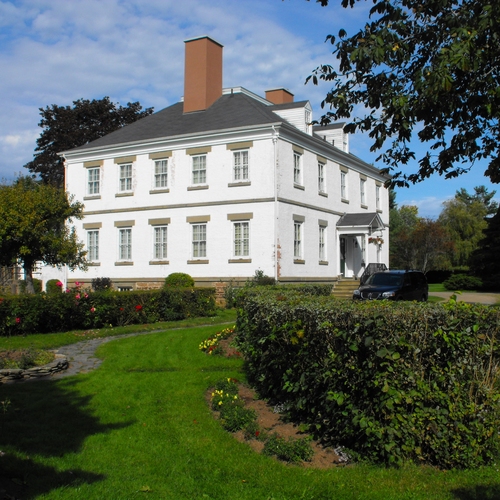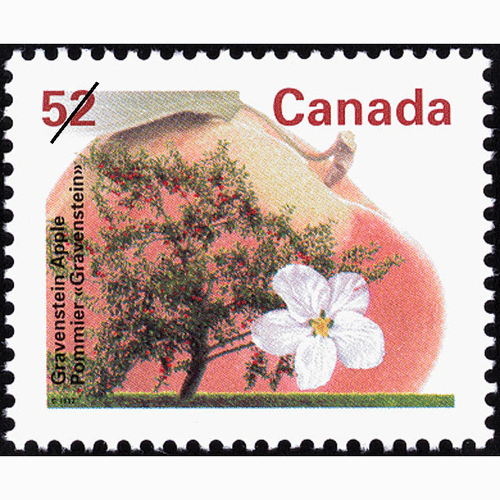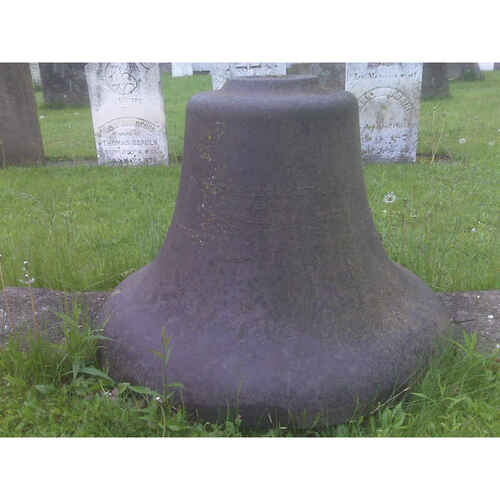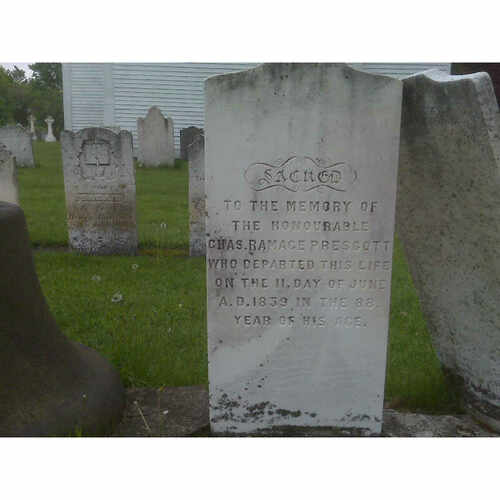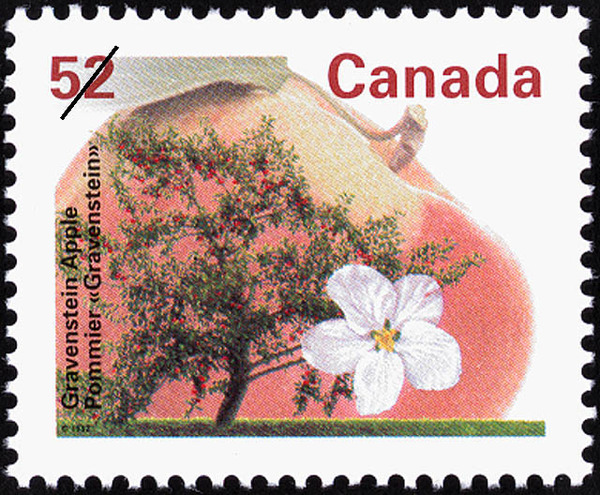
Source: Link
PRESCOTT, CHARLES RAMAGE, merchant, politician, justice of the peace, office holder, and horticulturist; b. 6 Jan. 1772 in Halifax, seventh child and fourth son of Jonathan Prescott and Anne Blagden; m. first 6 Feb. 1796 Hannah Whidden (d. 1813), and they had seven children; m. secondly 9 Feb. 1814 Mariah Hammill, and they had five children; d. 11 June 1859 in Cornwallis, N.S.
Charles Ramage Prescott was a Nova Scotian pre-loyalist of impeccable credentials. His father, a surgeon and engineer in the siege of Louisbourg, Île Royale (Cape Breton Island), in 1745, had settled in Halifax by 1752, where he established himself as a luckless entrepreneur under Joshua Mauger*’s influence. Charles’s brothers were respectively a doctor, a yeoman farmer, and Halifax’s first commercial brickmaker; a sister married the prominent merchant Rufus Fairbanks. Charles himself took up the profession of his brother-in-law, and by 1800 had established himself in partnership with another pre-loyalist, William Lawson*. During the next decade, Prescott and Lawson epitomized Halifax’s prosperous waterfront in the Napoleonic era: trading to the Iberian Peninsula, the West Indies, and the Canadas; privateering on the south Atlantic; and trans-shipping British goods to the United States to thwart the embargo. In 1809 Joseph Allison, later the husband of Prescott’s eldest daughter, joined the partnership to form Prescott, Lawson and Company. The following year Lawson, mla for Halifax County since 1806, sold his interest in the firm to Prescott, who himself sold half their wharf a year later to entrepreneur Enos Collins*. On 31 Dec. 1811 Prescott, Lawson and Company was dissolved, Allison alone apparently remaining active in commerce. Throughout the life of the firm, Prescott had been its senior partner. As such, he played an active role in Haligonian commercial life, subscribing for the apprehension of naval deserters, buying government bills at discount, participating fully in the Halifax Committee of Trade, and favouring the formation of a local joint-stock bank.
The dissolution of the firm, however, brought an end to Prescott’s mercantile career. By mid 1812 he had left Halifax, reportedly on account of his health, to settle in Cornwallis. Here, he built a handsome seat, the fine neoclassical “Acacia Grove,” where he pursued the life of a country squire. A magistrate, warden of the parish church, and trustee of the grammar school, he invested in local mortgages and took part in regional improvement, serving as a commissioner for erecting a bridge and as president of the agricultural society. From 1818 to 1820 he was mla for Cornwallis Township; he was not an active legislator and, upon dissolution of the assembly at the death of George III, he was replaced by John Wells.
Prescott fitted more comfortably into the Council, to which he was appointed in 1825. For over a decade the only councillor resident outside the capital, he attended his unremunerated duty with admirable regularity during legislative sessions, though not at other times. The brother-in-law of an Anglican clergyman, he maintained a conservative position on controversial religious and educational issues such as the Pictou Academy [see Thomas McCulloch*]. On commercial matters, his views were likewise conservative, befitting a successful, if retired, merchant and a substantial shareholder in the provincial debt. Host to successive lieutenant governors at his country estate, Prescott was “of the stuff councillors are made of.” It was no doubt this quality which led to his retirement in 1838 when Lieutenant Governor Sir Colin Campbell* was instructed to broaden the representative character of his advisers. Prescott was succeeded by his former partner Lawson.
It was neither for his mercantile career nor for his political role that Prescott was renowned. Rather, it was for his horticultural exploits. Like many of his contemporaries, including John Young*, he was an enthusiastic promoter of scientific agriculture, testing, for example, different varieties of wheat as a cereal crop and Swedish turnips as feed for sheep. A subscriber to John Claudius Loudon’s famed Gardener’s Magazine, he also cultivated the ornamental shrubberies and colourful exotics characteristic of contemporary English landscape gardening. In a province where functional landscaping remained the norm, his property was a showpiece of the era’s “taste for improvement.”
Prescott’s interests far exceeded those of a fashionable country gentleman. His principal horticultural contribution lay in pomology. Importing a wide variety of fruit-trees from England, the United States, and Lower Canada, he created extensive orchards and noted hot-houses where he cultivated apples, apricots, cherries, grapes, melons, nectarines, peaches, pears, plums, and strawberries. He reportedly grafted and tested more than 100 varieties of apples and nearly 50 varieties each of pears and plums, from which he willingly gave scions to other cultivators. Although his activity pre-dated commercial fruit-growing in the province, he is credited with having introduced six of the ten varieties of apples, including the Gravenstein, which led the market during Nova Scotia’s heyday as an apple producer. President of the short-lived King’s County Horticultural Society, vice president of the Nova Scotia Horticultural Society when founded in 1836, and a member of the Massachusetts Horticultural Society, Prescott was lauded for his “zeal in Horticulture . . . only equalled by his rare knowledge, and still rarer liberality.”
Kings County Court of Probate (Kentville, N.S.), Loose wills and estate papers, no.36 (C. R. Prescott) (mfm. at PANS). N.S. Museum (Halifax), Prescott papers. PANS, MG 1, 793; MG 2, 728, nos.535a–b, 587; MG 100, 209, no.36; RG 1, 192: 196; 194–96; 218SS–218DDD; RG 8, 6, no.9 (especially 16 Oct. 1820; 10 March, 15 May 1823; 8 Jan. 1824); 15, no.25. PRO, CO 217/152: 201–4. Simeon Perkins, The diary of Simeon Perkins, 1790–1796; 1797–1803; 1804–1812, ed. C. B. Fergusson (Toronto, 1961; 1967; 1978). Acadian Recorder, 1 June 1816; 20 Feb., 6 March, 1 May 1819; 1 July 1820; 24 March 1821; 3 Sept. 1825; 18 June 1859. Novascotian, 24 Aug., 14, 21 Sept. 1836; 9 Oct. 1839; 17 July 1843; 29 Sept. 1845; 2 March 1846; 4 Sept. 1848; 20 Sept. 1852; 20 June 1859. Nova-Scotia Royal Gazette, 7 July, 1 Sept. 1807; 22 July, 30 Aug. 1808; 6, 27 June 1809; 27 Feb. 1810; 3, 20 Feb., 24 April 1811. Times (Halifax), 8 Sept. 1846. T. M. Punch, “Jonathan Prescott, M.D. – vincit qui partitur,” N.S. Hist. Quarterly (Halifax), 9 (1979): 59–80. The standard cyclopedia of horticulture . . . , ed. L. H. Bailey (3v., New York, 1933), 2: 1590. Beck, Government of N.S. Susan Buggey, “Some considerations regarding the Prescott House, Starr’s Point, Nova Scotia” (paper prepared for Can., Parks Canada, National Hist. Parks and Sites Branch, Ottawa, 1973). Eaton, Hist. of King’s County.
Cite This Article
Susan Buggey, “PRESCOTT, CHARLES RAMAGE,” in Dictionary of Canadian Biography, vol. 8, University of Toronto/Université Laval, 2003–, accessed December 31, 2025, https://www.biographi.ca/en/bio/prescott_charles_ramage_8E.html.
The citation above shows the format for footnotes and endnotes according to the Chicago manual of style (16th edition). Information to be used in other citation formats:
| Permalink: | https://www.biographi.ca/en/bio/prescott_charles_ramage_8E.html |
| Author of Article: | Susan Buggey |
| Title of Article: | PRESCOTT, CHARLES RAMAGE |
| Publication Name: | Dictionary of Canadian Biography, vol. 8 |
| Publisher: | University of Toronto/Université Laval |
| Year of publication: | 1985 |
| Year of revision: | 1985 |
| Access Date: | December 31, 2025 |


